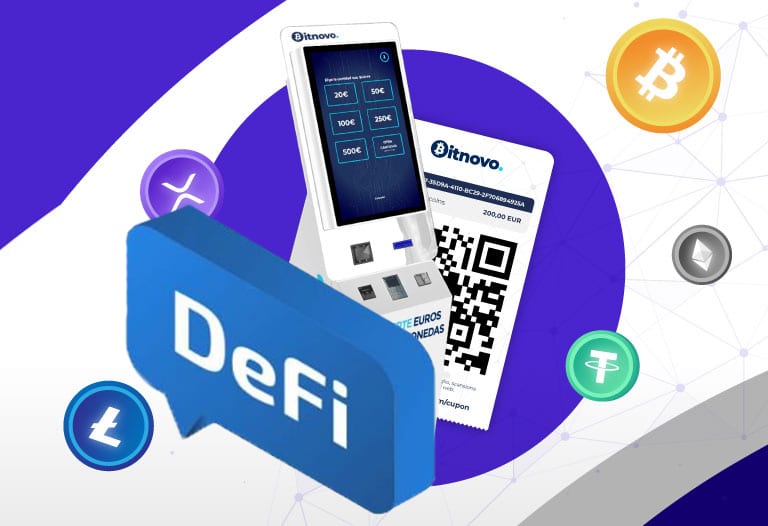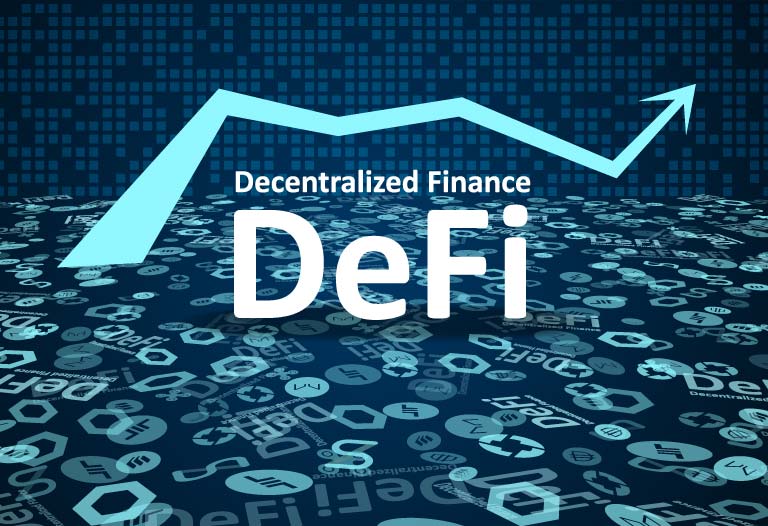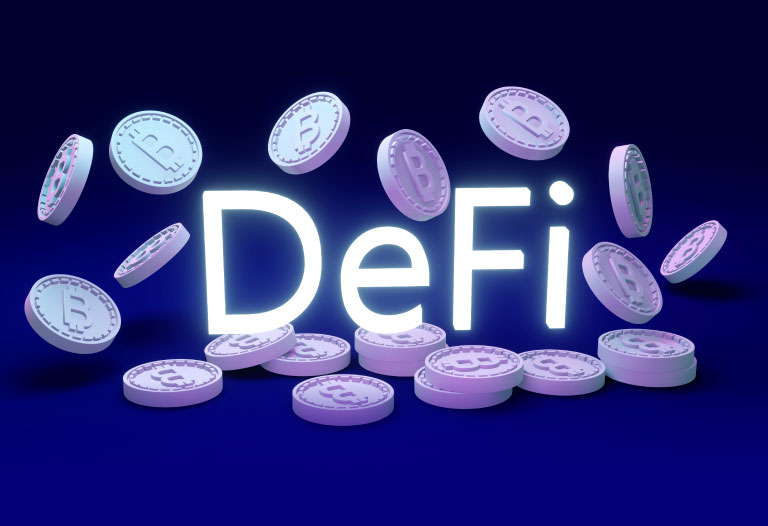
Table of Contents
ToggleThe first step is always very important. Bitnovo, is here to help you get started in the crypto-world in a simple and friendly way. But how about going a step further and venturing into DeFi strategies that you could follow after buying cryptocurrencies at Bitnovo?
Many users are unaware that after getting their first cryptocurrencies, they can receive returns in exchange for investing them. But to achieve them, it is necessary to know the possibilities that the DeFi ecosystem offers.
Today, it is my turn to advance in this sense and present some strategies, as an example, to take advantage of the benefits that DeFi has to grant us, after the purchase of cryptos in Bitnovo.
What do you need to know about DeFi beforehand?
The DeFi world in particular, and the crypto ecosystem in general, are not risk-free. Perhaps in part, it is this characteristic that allows for superlative returns compared to the world of traditional finance.
The greater the risk, the greater the benefit, we often hear. The elimination of risks, to the maximum extent possible, also requires economic resources that sooner or later fall back on the users, cutting their benefits.
When we are holders of a non-custodial wallet like the one Bitnovo provides us with, we are in charge of its security. Those 12 or 24 words that we receive, give us the possibility to recover our funds on the device that is necessary.
We know this freedom, as well as the responsibility that comes with it. Now, interacting with the DeFi ecosystem, we face a new scenario.
But what risks are we exposed to in the DeFi ecosystem?
First, we should understand what we are doing when we make use of the tools that DeFi offers us. This ecosystem is made up of an increasingly varied set of applications that replicate and innovate options from the world of traditional finance, but in a decentralized way.
How do they achieve the latter? By mounting or launching these applications on blockchains or blockchains. So what are the risks? These decentralized applications that make up the DeFi ecosystem, are nothing more than pieces of computer code, known as “Smart Contracts”.
Smart contracts are created to react predictably to similar stimuli. For example, a smart contract is created in order to return a percentage of return for each deposit, according to the amount deposited. Simple.
Now, behind them there is no company that guarantees the replacement of the funds deposited in it in case of a “hack” or theft of the contract. Therefore, when we enter this world, we expose ourselves to this type of risk.
Some precautions to take into account
There are methods to mitigate them, never 100%, but they do reduce the chances of losses. A thorough research on the particular application, its past, the team behind it, the community around it, are unavoidable issues prior to an interaction with this world.
Third-party audits and insurance coverage of funds are tools that are being developed in the ecosystem. However, they are not enough to guarantee total risk mitigation, which, as I said at the beginning, is an inherent part of this system.
The necessary disclaimer
Having clarified the above points, it is necessary to mention that nothing mentioned in this article, also extending to the content of this blog, is a financial advice or recommendation.
From our point of view, we try to present a scenario of the possibilities that this world offers us, giving an informative vision on the matter and inviting the readers to do their own research on the matter.
With the picture, perhaps, a little clearer, let’s see what strategies are available.

5 DeFi strategies, which we can follow from Bitnovo
First, I will focus on 3 options to make DeFi in Bitcoin, the most important cryptocurrency and the one that has given birth to this ecosystem. While secondly I will give mention to two strategies or DeFi options for ETH and stable coins, created in that network, that Bitnovo offers.
Without further ado, let’s move on to the analysis.
3 options for DeFi with Bitcoin
Money on Chain
Undoubtedly, Money on Chain is the most well-known protocol that provides DeFi strategies for BTC in the ecosystem. It issues the Dollar on Chain stablecoin, identified with the ticker DOC. You can imagine that such “stable” character is related to the parity it maintains with the US dollar.
The particularity of DOC is undoubtedly its collateral, the one that gives it value or backing, and it is none other than bitcoin. Therefore, a strategy to follow would be to deposit our BTC here and issue this stable currency that offers different investment options, in the RSK blockchain.
Another option within Money on Chain, is the BitPro token, BPRO, whose price is related to that of BTC, but with an exponential exposure to it. Both increases and decreases in BTC have a greater impact on this token.
Having any of these assets in our possession, we will receive MOC, the governance token of the Money on Chain protocol. This token allows us to participate in the governance of the protocol or to pay commissions on the platform. But, it is also monetizable and can be sold or exchanged for other tokens.
Now, how to get to Money on Chain?
This protocol is deployed on the RSK network, a sidechain of the Bitcoin blockchain. It is a network that “runs” or operates in parallel to the Bitcoin network, but uses its miners to obtain its security.
The step I will describe below is necessary, not only to invest in Money on Chain, but in the next two options I will discuss, which are also hosted on the RSK network:
- After buying BTC on Bitnovo, we must convert them into rBTC, which is a cryptocurrency supported by the RSK network.
- Once we have rBTC in our wallet, we can interact with these platforms. For example, we “block” or “deposit” our rBTC in the Money on Chain contract, to obtain our DOC or bPRO.
- Money on Chain supports several wallets, to which the RSK network must be configured beforehand.
Tropykus
Another protocol, hosted on the RSK blockchain. This is a lending and deposit application, which also allows for exchanges within it. Unlike Money on Chain, it does not have its own stablecoin, but supports the use of DOC, rUSDT and xUSD.
By depositing our cryptos here, we will be able to get annual interest rates ranging from 3% to 6.5%. As for loans, the rates vary between 4% and 9.7% depending on the currency we request. It is not minor to highlight, that we will need to leave a collateral as a guarantee of our loan, which of course must be another cryptocurrency.
An example of what we can do here, is to request a DOC (Dollar on chain) loan by depositing our rBTC as collateral in the platform. The famous “money legos” of the DeFi ecosystem in action.
Sovryn
Sovryn is a DeFi protocol that includes a lending and investment platform and a decentralized exchange where we can exchange our cryptocurrencies.
Unlike a traditional exchange, Sovryn’s decentralized exchange works through “smart contracts”. In practice, this means that by connecting our wallet here, we will never give up ownership of our funds.
This is the origin of the platform’s name, derived from a sort of play on the word “sovereign”, whose translation into English can be synthesized as sovereign.
As we have commented so many times in this blog, the possibility of guarding our own holdings is one of the greatest attributes of the DeFi ecosystem.
The interest rates, which Sovryn is paying on deposits, are as follows:
- rBTC 0,29%
- XUSD 6,36%
- DoC 3,70%
- rUSDT 26,4%
- BPRO 0,06%
As in Tropykus, this platform provides the opportunity to obtain a loan in exchange for the deposit of collateral.
A game that is often played, using the variety of DeFi protocols, is to request a loan on one platform and deposit these coins on another whose return is greater than the cost of the loan.
Another opportunity here is the provision of liquidity on the platform, in exchange for which the platform token, SOV, is obtained. Although the risk, because of the volatility of the pairs, is higher, it can be a good strategy.
2 options for DeFi on Ethereum
Aave
Focusing now on the Ethereum network, we find one of the oldest protocols in the DeFi ecosystem, which has an impeccable track record and reputation.
This deposit and lending platform, set a standard in the industry and is not only found in the Etheruem network, but has spread to different networks that make up our ecosystem such as Polygon, Harmony or Arbitrum, among others.
In its application deployed on the Ethereum network, we can deposit more than 20 different cryptos, while we can request loans granting the same variety of coins.
Another option that Aave gives us, is to deposit the platform’s own tokens, in exchange for a return that today is around 30% per year.
The DeFi ecosystem was born in the Ethereum network, so you will notice that, by simply analyzing an application, the options multiply.
How to get to Aave and implement this strategy?
The way to be able to carry out an investment in the aforementioned platform, is quite simpler than what I have described in the options with bitcoin. The reason is simple. To use the Ethereum network, we do not have to configure any type of network, we simply have to create one of the wallets that support this network and that allow interaction with decentralized applications.
What we must keep in mind, when trying this option or the following one, is that in our Ethereum wallet we must always have some “spare” ETH. Every movement we make in this blockchain, will have a cost, called “gas“, which must be paid by means of ETH.
So, if we want to interact with Aave, we should send us ETH to the address of our Ethereum wallet that will allow us to interact with these dApps and calculate, in this shipment, an amount greater than the amount we want to invest, to cover these costs I mention. We must not lose sight of the fact that we will not only have to pay the deposit in the application, but also the withdrawal.
Yearn Finance
Another crypto industry standard. Created by an extremely well-known character in the ecosystem, Andre Cronje, Yearn was born as a solution to a clear problem. Andre was tired of moving his stable coins all over the Ethereum network, looking for the best returns.
So, he created a smart contract that would do it for him. From there, the project evolved into one of the most complex in the ecosystem. In Yearn we can deposit our coins, while behind it will develop strategies built in such a way that we get the highest profits existing in the Ethereum network.
Reviewing the number of coins and strategies available on Yearn Finance would take us more than one article, so I invite you to go through this platform on your own.
It should be noted that the Ethereum network, to date, has a major drawback and that is the price of its fees, known as “gas“, when making transactions. While we await the updates that seek to scale and make the network more efficient, it is a cost that we must take into account when interacting with this network.
The road to Yearn
Identical is the journey that we must go through from having bought our first coins in Bitnovo, to get to Yearn, as the path described in the section dedicated to Aave. Having an Ethereum wallet, compatible to interact with decentralized applications and some backup ETH to pay for the “gas”, will be sufficient resources.
Once we have sent the necessary funds to the target wallet, we will only need to choose the strategy to implement in Yearn, connect and deposit the necessary cryptos to start generating returns on the platform. It is worth mentioning that if we only have ETH in our wallet and we need another crypto to invest in Yearn, Uniswap, the largest DEX on the network, will be the right place to make the necessary “swap”.

Conclusion
This article is just a review of five options or strategies that we could take after buying our cryptocurrencies in Bitnovo.
The DeFi ecosystem, after several years of development, has ceased to belong exclusively to the Ethereum network to reach different blockchains, which present us with different options or strategies, with an extremely varied collection of return percentages and risks to consider.
Perhaps the reading of this article, will awaken the interest of a few users, to launch directly into the investigation of the options that DeFi has to offer. Undoubtedly, a growing ecosystem with room for everyone.






